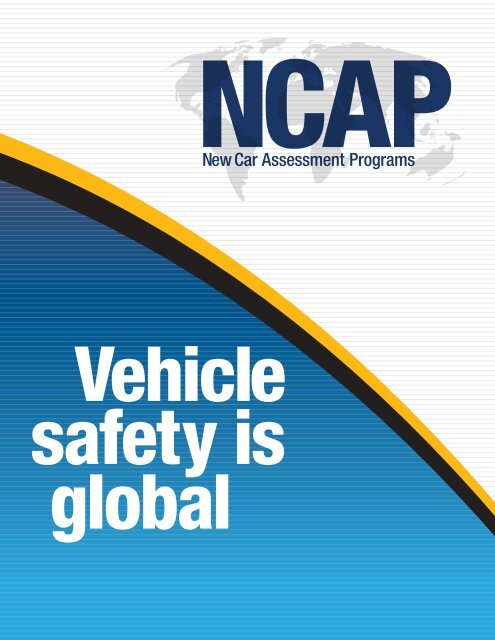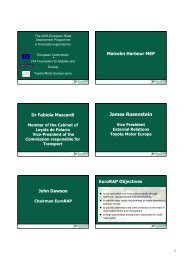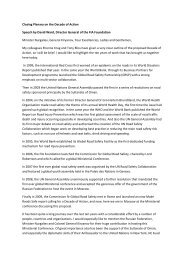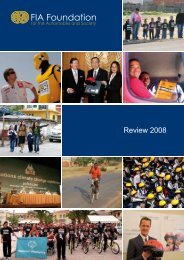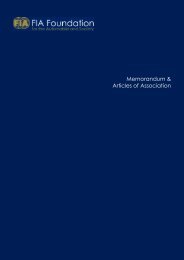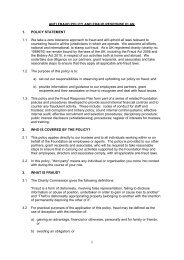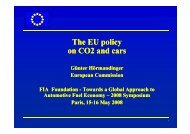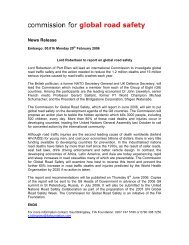Vehicle safety is global - Global NCAP
Vehicle safety is global - Global NCAP
Vehicle safety is global - Global NCAP
You also want an ePaper? Increase the reach of your titles
YUMPU automatically turns print PDFs into web optimized ePapers that Google loves.
<strong>NCAP</strong><br />
New Car Assessment Programs<br />
<strong>Vehicle</strong><br />
<strong>safety</strong> <strong>is</strong><br />
<strong>global</strong>
The world<br />
<strong>is</strong> getting<br />
smaller.<br />
In today’s <strong>global</strong> marketplace the options for goods and services are endless, but it can be hard for consumers to<br />
sort through them and make choices that are in their best interests. Nowhere <strong>is</strong> that more true than in the worldwide<br />
automotive market, where new car buyers are presented with a dizzying array of vehicles in all shapes, sizes,<br />
and price ranges that come with a wide variety of features and <strong>safety</strong> technologies.<br />
Fortunately, vehicle buyers can increasingly turn for guidance to independent new car assessment and crash<br />
test programs that have been establ<strong>is</strong>hed or are being set up in countries around the world. By operating vehicle<br />
test programs under internationally recognized protocols, these New Car Assessment Programs (<strong>NCAP</strong>s) aim to<br />
provide consumers with <strong>safety</strong> information that will ass<strong>is</strong>t their purchasing dec<strong>is</strong>ions.<br />
The United Nations resolution proclaiming 2011-20 the Decade of Action for Road Safety l<strong>is</strong>ts vehicle <strong>safety</strong> as<br />
a central pillar of the road <strong>safety</strong> activities. The UN’s <strong>global</strong> plan for the decade of action calls on countries to<br />
encourage implementation of <strong>NCAP</strong>s in all regions of the world and to recognize the importance of <strong>safety</strong> belts, as<br />
well as more recent innovations such as electronic stability control and antilock braking systems in motorcycles.<br />
These features have been promoted and factored into vehicle testing by <strong>NCAP</strong>s for years. In the <strong>global</strong> automotive<br />
marketplace, consumers’ rights are being championed by these programs, with support from a range of stakeholders<br />
including governments, motoring clubs, and insurers.<br />
<strong>NCAP</strong>: <strong>Vehicle</strong> Safety <strong>is</strong> <strong>Global</strong> <strong>is</strong> the theme for th<strong>is</strong> joint presence by a number of <strong>NCAP</strong>s at th<strong>is</strong> ESV Conference.<br />
It reflects the strategic aim that consumers around the world should have access to <strong>safety</strong> ratings and information<br />
when shopping for a new vehicle.<br />
Please read on to learn about the activities of these various New Car Assessment Programs and the way they<br />
operate in their different countries and regions.4
<strong>global</strong>ncap.org<br />
60 Trafalgar Square<br />
London WC2N 5DS<br />
UNITED KINGDOM<br />
T +44 (0) 20 7 747 5195<br />
info@<strong>global</strong>ncap.org<br />
UN Secretary General Ban Ki-moon and Michael Bloomberg at the launch of the Decade of Action<br />
Promoting Safer Cars Worldwide<br />
Over the next 10 years the number of passenger vehicles on the planet<br />
<strong>is</strong> expected to double. Most of that growth <strong>is</strong> taking place in emerging<br />
markets, where the road <strong>safety</strong> challenge <strong>is</strong> greatest. For the first time<br />
last year sales of passenger vehicles in those countries exceeded those<br />
in mature economies.<br />
The <strong>Global</strong> New Car Assessment Programme (<strong>Global</strong> <strong>NCAP</strong>) <strong>is</strong> a new<br />
nonprofit organization reg<strong>is</strong>tered in the United Kingdom that aims to<br />
meet th<strong>is</strong> challenge by encouraging the worldwide availability of independent<br />
consumer information about the <strong>safety</strong> of motor vehicles.<br />
<strong>Global</strong> <strong>NCAP</strong> has been establ<strong>is</strong>hed to support the goals of the UN<br />
Decade of Action for Road Safety, which aims to cut in half the<br />
predicted increase in road fatalities by 2020. New car assessment<br />
programs have proved very effective in creating a market for <strong>safety</strong> that<br />
encourages car purchasers to choose safer products, and the UN plan<br />
encourages their establ<strong>is</strong>hment throughout the world.<br />
<strong>Global</strong> <strong>NCAP</strong> promotes the development of <strong>NCAP</strong>s and similar organizations<br />
worldwide and encourages best practices in the use of consumer<br />
information to promote road <strong>safety</strong>. The organization has adopted the<br />
following m<strong>is</strong>sion statement:<br />
• <strong>Global</strong> <strong>NCAP</strong> aims to support the development of new consumer<br />
crash test programs in emerging markets, where vehicle growth <strong>is</strong><br />
strong but independent consumer information on crashworthiness<br />
<strong>is</strong> frequently not readily available. To achieve th<strong>is</strong>, <strong>Global</strong> <strong>NCAP</strong><br />
will offer support to new car assessment programs in emerging<br />
economies and regions by offering technical support guidance and<br />
quality assurance.<br />
• <strong>Global</strong> <strong>NCAP</strong> will also provide a platform for cooperation for <strong>NCAP</strong>s<br />
and similar organizations around the world to share best practices, to<br />
further exchange information, and to promote the use of consumer<br />
information to encourage the manufacture of safer cars across the<br />
<strong>global</strong> automotive market.<br />
• <strong>Global</strong> <strong>NCAP</strong> will carry out research on innovations in vehicle <strong>safety</strong><br />
technologies, their application in <strong>global</strong> markets, and the range of<br />
policies that will accelerate their use and will monitor the progress of<br />
vehicle <strong>safety</strong> across the globe.<br />
• <strong>Global</strong> <strong>NCAP</strong> will also develop a <strong>global</strong> awards scheme to recognize<br />
achievement in vehicle <strong>safety</strong>, innovation in <strong>safety</strong>-related technologies,<br />
and products.<br />
In line with th<strong>is</strong> m<strong>is</strong>sion statement, <strong>Global</strong> <strong>NCAP</strong> in 2011 will be<br />
supporting the work of Latin <strong>NCAP</strong> and seeking cooperation with<br />
establ<strong>is</strong>hed vehicle <strong>safety</strong> organizations around the world.<br />
<strong>Global</strong> <strong>NCAP</strong> <strong>is</strong> governed by a board of trustees, chaired by Max<br />
Mosley, former president of the Federation Internationale de l’Automobile<br />
(FIA) and past chairman of the European New Car Assessment<br />
Programme. Other trustees include Guido Adriaenssens, of International<br />
Consumer Research & Testing; Lauchlan McIntosh, chairman of the<br />
Australasian New Car Assessment Program; Claes Tingvall, former<br />
chairman of the European New Car Assessment Programme; and David<br />
Ward, of the FIA Foundation.<br />
<strong>Global</strong> <strong>NCAP</strong> <strong>is</strong> pleased to acknowledge grant support from the<br />
FIA Foundation.
latinncap.com<br />
26 de Marzo 3454<br />
Of. 102 / ZC 11300<br />
Montevideo<br />
URUGUAy<br />
T +598 2628 8815<br />
secretaria@latinncap.com<br />
Latin <strong>NCAP</strong> provides consumers with real<strong>is</strong>tic and independent assessments<br />
of the <strong>safety</strong> performance of some of the most popular vehicles<br />
sold in Latin America and the Caribbean. By acting as a source of<br />
independent information for consumers, Latin <strong>NCAP</strong> gives manufacturers<br />
an incentive to improve the <strong>safety</strong> of their vehicles.<br />
Latin <strong>NCAP</strong> <strong>is</strong> a joint initiative of Region IV of the Federation Internationale<br />
de l’Automobile (FIA), the FIA Foundation, International Consumer<br />
Research & Testing (ICRT), and Fundación Gonzalo Rodríguez. It <strong>is</strong><br />
sponsored by the Inter-American Development Bank and <strong>is</strong> based in<br />
Montevideo, Uruguay.<br />
M<strong>is</strong>sion<br />
To deliver the v<strong>is</strong>ion of safer cars through:<br />
• Dialogue. As an advocate for <strong>safety</strong>, Latin <strong>NCAP</strong> works with all<br />
stakeholders, including leg<strong>is</strong>lators, manufacturers, researchers,<br />
other <strong>NCAP</strong> organizations, and insurers, to identify new priorities<br />
and encourage best practices.<br />
• Tests. Latin <strong>NCAP</strong> releases two types of ratings, adult occupant<br />
protection and child occupant protection, based on results of a<br />
frontal test.<br />
• Adult occupant protection. Points are awarded from the frontal<br />
test. Modifiers are also given to extend the assessment to cover<br />
different sizes of people in a variety of seating positions, in particular<br />
for the knee contact area. In the future, Latin <strong>NCAP</strong> plans to reward<br />
vehicles that have intelligent seat belt reminders as part of its adult<br />
protection rating.<br />
• Child occupant protection. Based on the Euro <strong>NCAP</strong> model, Latin<br />
<strong>NCAP</strong> has carried out a child occupant <strong>safety</strong> assessment since<br />
its first test to ensure that manufacturers take responsibility for the<br />
children traveling in their vehicles. Dummies representing 18-monthold<br />
and 3-year-old children are used in the frontal test. Child seat fit<br />
and vehicle instructions are also reviewed to make sure a seat can<br />
be installed safely and securely.<br />
• Ratings. Latin <strong>NCAP</strong> aims to stimulate the market by providing<br />
independent information to consumers, the media, member<br />
organizations, fleet buyers, and insurers.<br />
• Innovation. The organization sets high <strong>safety</strong> targets for manufacturers<br />
and encourages the development of new technologies.<br />
• Evaluation. The effectiveness of Latin <strong>NCAP</strong>’s activities <strong>is</strong> measured<br />
through accident analys<strong>is</strong> in order to shape future work.
car.go.kr<br />
<strong>Vehicle</strong> Management Div<strong>is</strong>ion, Min<strong>is</strong>try<br />
of Land, Transport & Maritime Affairs<br />
Jungang-dong, Gawcheon-city, Gyeonggi-do<br />
REPUBLIC OF KOREA<br />
T +82-2-2110-8698<br />
Dr. Jaewan Lee: jwlee@ts2020.kr<br />
The Korean New Car Assessment Program (K<strong>NCAP</strong>) <strong>is</strong> conducted by<br />
the Korea Automobile Testing Research Institute of the Korea Transportation<br />
Safety Authority under the auspices of the Min<strong>is</strong>try of Land,<br />
Transport, and Maritime Affairs of The Republic of Korea. K<strong>NCAP</strong> was<br />
introduced in 1999 to encourage vehicle manufacturers to build safer<br />
cars by providing consumers with vehicle <strong>safety</strong> information.<br />
K<strong>NCAP</strong> began with full-width frontal tests and has gradually increased<br />
the number of evaluations. Today the program includes full-width frontal<br />
tests, side tests, frontal offset tests using a deformable barrier, pole<br />
side impacts, evaluations of seats for whiplash prevention in rear-end<br />
coll<strong>is</strong>ions, and pedestrian protection evaluations. For active <strong>safety</strong>,<br />
rollover res<strong>is</strong>tance and braking performance are measured.<br />
Since 2010, K<strong>NCAP</strong> has publ<strong>is</strong>hed overall <strong>safety</strong> ratings cons<strong>is</strong>ting of<br />
scores in the two frontal tests, the side-impact test, the pole test, and<br />
the whiplash test. <strong>Vehicle</strong>s are rated on a 5-point scale. K<strong>NCAP</strong> also<br />
presents an award for the safest car of the year.<br />
The ratings are primarily for passenger vehicles. Small trucks and buses<br />
are evaluated from time to time, depending on the number sold.<br />
Since the introduction of K<strong>NCAP</strong> in 1999, many <strong>safety</strong> features have<br />
become standard equipment in most passenger vehicles. In the beginning,<br />
airbags were expensive and were standard equipment in only<br />
high-end passenger vehicles. Now airbags (frontal, side, and curtain)<br />
are standard in most models. Today most passenger vehicles earn 4<br />
stars or more, evidence that K<strong>NCAP</strong> has been successful in its m<strong>is</strong>sion<br />
of improving vehicle <strong>safety</strong>.<br />
CURRENT CrashWORThiness ProgramS<br />
• full-width frontal crash test<br />
• side-impact crash test<br />
• frontal offset test<br />
• pole side-impact test<br />
• rear tests for whiplash prevention<br />
• pedestrian protection evaluation<br />
CURRENT Active Safety ProgramS<br />
• braking performance (vehicles with antilock brakes)<br />
• rollover res<strong>is</strong>tance (only SUVs)<br />
fUTURE Plans<br />
• include 5th percentile female dummy in crash tests<br />
• new comprehensive rating system<br />
• new deformable barrier for side-impact tests
euroncap.com<br />
2 Place du Luxembourg<br />
1050 Brussels<br />
BELGIUM<br />
T +32 2 400 77 40<br />
info@euroncap.com<br />
The European New Car Assessment Programme provides consumers<br />
with a real<strong>is</strong>tic and independent assessment of the <strong>safety</strong> performance<br />
of some of the most popular cars sold in Europe. The organization has<br />
had an important influence on vehicle designs, leading to fewer traffic<br />
deaths on European roads.<br />
Establ<strong>is</strong>hed in 1997, Euro <strong>NCAP</strong> <strong>is</strong> a nonprofit international association,<br />
independent of the automotive industry. It’s backed by seven European<br />
governments (France, Germany, Sweden, the Netherlands, the United<br />
Kingdom, Luxembourg, and the Catalonia region of Spain), consumer<br />
groups through International Consumer Research and Testing, European<br />
motoring clubs through the Fédération Internationale de l’Automobile,<br />
and the Motor Insurance Repair Research Centre (Thatcham).<br />
CURRENT crashWORThiness programs<br />
<strong>Vehicle</strong> buyers owe it to themselves and their families to choose the<br />
safest vehicle. To do so they need reliable, accurate, and unbiased<br />
comparative information regarding the <strong>safety</strong> performance of individual<br />
models. By law, all new models must pass <strong>safety</strong> tests before they<br />
are sold, but these are minimum standards. Euro <strong>NCAP</strong> encourages<br />
manufacturers to exceed these minimum requirements. Euro <strong>NCAP</strong> has<br />
tested more than 400 vehicles since 1997.<br />
Euro <strong>NCAP</strong> releases an overall rating with a maximum of 5 stars for each<br />
vehicle. The rating <strong>is</strong> compr<strong>is</strong>ed of scores in four important areas:<br />
• adult protection (driver and passenger)<br />
• child protection<br />
The underlying dynamic tests include full-scale frontal and side-impact<br />
tests, front-end component tests for pedestrian protection, and sled<br />
tests for whiplash prevention during rear-end crashes. Seat belt<br />
reminders, speed limiters, and electronic stability control also boost a<br />
vehicle’s rating.<br />
Rewarding New Technologies: Euro <strong>NCAP</strong> Advanced<br />
Since 2010, Euro <strong>NCAP</strong> has been rewarding vehicle manufacturers<br />
that make available new technologies that provide a scientifically proven<br />
<strong>safety</strong> benefit for consumers and society. Many of these technologies<br />
focus on avoiding crashes by informing, adv<strong>is</strong>ing, and alerting drivers<br />
about dangerous situations. Some of them initiate autonomous braking<br />
as well. Recognizing these advances under Euro <strong>NCAP</strong> Advanced provides<br />
an incentive to manufacturers to accelerate the availability of new<br />
<strong>safety</strong> equipment across their model ranges and helps vehicle buyers<br />
factor these features into their purchase dec<strong>is</strong>ions.<br />
fUTURE Plans<br />
In 2012-15, Euro <strong>NCAP</strong> will be conducting extensive reviews of almost<br />
all its testing and assessment procedures. The objective <strong>is</strong> to make the<br />
5-star rating system even more meaningful in terms of real-world performance<br />
and the advancement of <strong>safety</strong> technology. Work has commenced<br />
on the development of an additional full-width frontal impact<br />
test using different-size dummies. There are also plans to implement a<br />
number of new test procedures focusing on emerging crash avoidance<br />
technologies and speed support systems.<br />
• pedestrian protection<br />
• <strong>safety</strong> ass<strong>is</strong>t technologies
Latin <strong>NCAP</strong><br />
Hybrid III<br />
50%<br />
P3<br />
ODB 40% 0º<br />
64 km/h<br />
Hybrid III<br />
50%<br />
P1.5<br />
• Credit for seat belt reminder<br />
• Child occupant protection<br />
• 2 star ratings (1-5) for<br />
adult and child protection<br />
• Pedestrian protection tests<br />
K<strong>NCAP</strong><br />
0º Hybrid III<br />
50%<br />
56 km/h<br />
Hybrid III<br />
50%<br />
Hybrid III<br />
50%<br />
ODB 40% 0º<br />
64 km/h<br />
Hybrid III<br />
50%<br />
ES-2<br />
MDB: EEVC<br />
950 kg<br />
55 km/h<br />
90º<br />
ES-2<br />
• Whiplash mitigation tests<br />
• Rollover res<strong>is</strong>tance testing<br />
• Brake evaluations<br />
• Single star rating (1-5)<br />
based on all results<br />
except brakes<br />
29 km/h<br />
Euro <strong>NCAP</strong><br />
ODB 40% 0º<br />
Hybrid III<br />
50%<br />
P3<br />
64 km/h<br />
Hybrid III<br />
50%<br />
P1.5<br />
P3<br />
ES-2<br />
P1.5<br />
MDB: EEVC<br />
950 kg<br />
50 km/h<br />
90º<br />
29 km/h<br />
ES-2<br />
• Pedestrian protection tests<br />
• Credit for ESC, speed<br />
limiters, seat belt reminder<br />
• Child occupant protection<br />
• Whiplash mitigation tests<br />
• Single star rating based on<br />
all results<br />
• Beyond <strong>NCAP</strong> awards for<br />
innovative driver ass<strong>is</strong>tance<br />
technology<br />
Test configurations<br />
Test diagrams adapted from:<br />
SafetyW<strong>is</strong>sen by<br />
www.carhs.de
IIHS<br />
Hybrid III<br />
50%<br />
ODB 40% 0º<br />
64 km/h<br />
SID IIs SID IIs<br />
MDB: IIHS<br />
1,500 kg<br />
50 km/h<br />
90º<br />
• Whiplash mitigation tests<br />
• <strong>Vehicle</strong> rating scale — good,<br />
acceptable, marginal, poor<br />
• TOP SAFETY PICK awarded to models<br />
that are rated good in all evaluations<br />
and offer ESC<br />
• Booster belt fit assessments —<br />
BEST BETS, GOOD BETS,<br />
not recommended, other<br />
• Low-speed damageability testing<br />
• Pedestrian protection tests<br />
J<strong>NCAP</strong><br />
0º Hybrid III<br />
50%<br />
55 km/h<br />
Hybrid III<br />
50%<br />
Hybrid III<br />
5%<br />
64 km/h<br />
ODB 40% 0º<br />
Hybrid III<br />
50%<br />
55 km/h<br />
90º<br />
MDB: EEVC<br />
950 kg<br />
ES-2<br />
• Child occupant protection<br />
• Whiplash mitigation tests<br />
• Brake evaluations<br />
• Single star rating (1-6) for<br />
occupant protection only<br />
• Grand Prix Award for best<br />
vehicles of the year<br />
A<strong>NCAP</strong><br />
Hybrid III<br />
50%<br />
64 km/h<br />
ODB 40% 0º<br />
Hybrid III<br />
50%<br />
50 km/h ES-2<br />
90º<br />
MDB: EEVC<br />
950 kg<br />
ES-2<br />
• Pedestrian protection tests<br />
• Credit for ABS, ESC, seat belt<br />
reminder<br />
• Child occupant protection<br />
• Single star rating (1-5) based<br />
on all results<br />
P3<br />
P1.5<br />
29 km/h<br />
U.S. <strong>NCAP</strong><br />
0 º<br />
Hybrid III<br />
50%<br />
56 km/h<br />
Hybrid III<br />
5%<br />
ES-2re<br />
50%<br />
SID IIs<br />
5%<br />
55 km/h<br />
62 km/h<br />
MDB: U.S. FMVSS 214<br />
1,368 kg<br />
SID IIs<br />
5%<br />
32 km/h<br />
75º<br />
15º<br />
• Rollover res<strong>is</strong>tance testing<br />
• Single star rating (1-5)<br />
based on all results<br />
• Recommends ESC,<br />
forward-coll<strong>is</strong>ion warning,<br />
and lane-departure warning<br />
meeting U.S. <strong>NCAP</strong> criteria
<strong>Global</strong> <strong>NCAP</strong><br />
Frontal offset test of a Geely CK1 at 64 km/h by Latin <strong>NCAP</strong>,<br />
one of the new programs that <strong>Global</strong> <strong>NCAP</strong> <strong>is</strong> ass<strong>is</strong>ting<br />
4<br />
Test photos<br />
K<strong>NCAP</strong><br />
Side impact crash test of a Hyundai Avante at 55 km/h<br />
4<br />
Latin <strong>NCAP</strong><br />
Frontal offset test of a Toyota Corolla at 64 km/h<br />
4<br />
Euro <strong>NCAP</strong><br />
Frontal test at 64 km/h by Euro <strong>NCAP</strong> (2010)<br />
4
IIHS<br />
IIHS a crashworthiness R&D test at<br />
64 km/h, 25 percent overlap with rigid barrier<br />
4<br />
A<strong>NCAP</strong><br />
First crash test of the Chery J1 (3-star rating)<br />
4<br />
J<strong>NCAP</strong><br />
Pedestrian leg protection performance test<br />
at 40 km/h using a FLEX leg impactor (new in 2011)<br />
4<br />
U.S. <strong>NCAP</strong><br />
Side impact pole test at 32 km/h, 75-degree impact angle<br />
4
iihs.org<br />
<strong>Vehicle</strong> Research Center<br />
988 Dairy Road<br />
Ruckersville, VA 22968<br />
USA<br />
T +1 (434) 985-4600<br />
vrc@iihs.org<br />
The Insurance Institute for Highway Safety, founded in 1959, <strong>is</strong> an independent,<br />
nonprofit, scientific, and educational organization dedicated to<br />
reducing the losses — deaths, injuries, and property damage — from<br />
crashes on the nation’s highways. The work of IIHS <strong>is</strong> wholly supported<br />
by U.S. insurers.<br />
The Institute’s <strong>Vehicle</strong> Research Center was dedicated in 1992, and<br />
crash research conducted there eventually led to IIHS front crashworthiness<br />
ratings in 1995. At the same time, IIHS was rating vehicle head<br />
restraint geometry to encourage designs better able to mitigate whiplash<br />
injuries. IIHS added side crashworthiness ratings in 2004 and also<br />
began basing its whiplash mitigation ratings on results of simulated rear<br />
crashes (sled tests). In 2009, IIHS began rating roof strength to promote<br />
better rollover crashworthiness.<br />
TOP SAFETY PICK, IIHS’s highest <strong>safety</strong> accolade, was initiated in<br />
2006 to help consumers easily identify those vehicle designs that had<br />
achieved the highest level of crashworthiness as indicated by results<br />
of IIHS tests. It has also been used to promote other life-saving <strong>safety</strong><br />
features such as electronic stability control (ESC). TOP SAFETY PICK<br />
continues to evolve, ever ra<strong>is</strong>ing the bar for <strong>safety</strong> in the U.S.<br />
CURRENT programs<br />
IIHS maintains front, side, roof, and whiplash mitigation ratings for about<br />
190 current model vehicle designs that represent about 92 percent of<br />
the new passenger vehicle fleet in the United States. Research using<br />
crash records indicates that occupants of vehicles with good ratings in<br />
IIHS tests have reduced r<strong>is</strong>k of injury and death:<br />
• In 2-vehicle frontal crashes, the driver fatality r<strong>is</strong>k in vehicles with<br />
good IIHS front ratings <strong>is</strong> 46 percent lower than in those rated poor.<br />
• Among vehicles with standard side airbags for the head and torso,<br />
those with good IIHS side crash ratings have a driver fatality r<strong>is</strong>k that<br />
<strong>is</strong> 70 percent less than that of those rated poor.<br />
• Research that led to the initiation of IIHS roof strength tests<br />
indicates that the r<strong>is</strong>k of serious injury or death <strong>is</strong> reduced by 34<br />
percent in rollover crashes among good-rated vehicles compared<br />
with poor ones.<br />
• The r<strong>is</strong>k of neck injury in rear crashes <strong>is</strong> 15 percent lower for drivers<br />
in seats with good ratings than for those in seats rated poor. For<br />
injuries lasting 3 months or more, the difference <strong>is</strong> 35 percent.<br />
In addition to front, side, roof, and rear <strong>safety</strong> crash ratings, IIHS<br />
rates vehicle bumpers for their ability to prevent expensive damage<br />
in low-speed crashes. Since 2008, IIHS has rated belt-fitting booster<br />
seats for their ability to correctly position <strong>safety</strong> belts on children in a<br />
variety of vehicles.<br />
fUTURE plans<br />
IIHS researchers are developing a new frontal crash test to evaluate<br />
a vehicle’s ability to protect occupants in frontal crashes with smaller<br />
overlap than the current IIHS frontal test.<br />
IIHS researchers are monitoring real-world performance of driver ass<strong>is</strong>tance<br />
and crash avoidance technologies with the intention of promoting<br />
those that are shown to be effective at helping drivers avoid crashes.<br />
Recent IIHS research suggests the possible need for compar<strong>is</strong>on testing<br />
of heavy truck underride guards.
www.nasva.go.jp<br />
6-1-25 Koji-machi, Chiyoda-ku<br />
Tokyo 102-0083<br />
JAPAN<br />
JARI test facility<br />
Inset: NASVA headquarters<br />
T +81-3-5276-4477<br />
admin@nasva.go.jp<br />
The Japan New Car Assessment Program (J<strong>NCAP</strong>) has been evaluating<br />
the <strong>safety</strong> of vehicles since 1995. The program aims to encourage the<br />
development and widespread use of safer vehicles by providing <strong>safety</strong><br />
information to consumers. It <strong>is</strong> carried out by the Min<strong>is</strong>try of Land, Infrastructure,<br />
Transport, and Tour<strong>is</strong>m and the National Agency for Automotive<br />
Safety and Victims’ Aid (NASVA). Testing <strong>is</strong> conducted at the Japan<br />
Automobile Research Institute.<br />
J<strong>NCAP</strong> releases overall ratings of crash <strong>safety</strong> performance of more<br />
than 100 models, covering more than 80 percent of new vehicles sold<br />
on the Japanese market. Child seat <strong>safety</strong> tests — a frontal coll<strong>is</strong>ion<br />
test and a usability test —have been part of the program since 2001.<br />
Since 2007, NASVA has been awarding the J<strong>NCAP</strong> Grand Prix to the<br />
vehicle model that earns the best ratings among all vehicle models that<br />
were evaluated for the first time in a given year.<br />
CURRENT CRASHWORTHINESS PROGRAMS<br />
J<strong>NCAP</strong> began with full-width frontal tests and braking performance<br />
tests in 1995. A side-impact test was added in 1999, followed by a<br />
frontal offset test the following year. Overall crash performance ratings<br />
have been released since 2000, based on the three crash tests.<br />
The following tests and evaluations are also conducted:<br />
• neck injury (whiplash) mitigation test for rear-end coll<strong>is</strong>ion<br />
performance (since 2009)<br />
• rear seat belt usability evaluation (since 2009)<br />
• passenger seat belt reminder evaluation<br />
• evaluation of rear-seat passenger protection as part of<br />
the frontal offset test (since 2009)<br />
A 2007 analys<strong>is</strong> of crash data showed a correlation between a vehicle’s<br />
J<strong>NCAP</strong> rating and the rate of fatality and seriously injury. Based on th<strong>is</strong><br />
research, it <strong>is</strong> estimated that more than 5,000 fatalities and more than<br />
130,000 serious injuries were prevented from 1995 to 2007 as a result<br />
of J<strong>NCAP</strong>’s work.<br />
FUTURE PLANS<br />
In 2011, J<strong>NCAP</strong> intends to begin testing vehicles for pedestrian leg<br />
protection and for protection against electrical shock after a coll<strong>is</strong>ion.<br />
J<strong>NCAP</strong> also plans to start a new overall rating for <strong>safety</strong> performance<br />
that will combine not only the results of all the crash tests, but also<br />
head and leg pedestrian protection and the seat belt reminder evaluation.<br />
In addition, J<strong>NCAP</strong> <strong>is</strong> studying evaluation methods for crash<br />
avoidance technologies.<br />
• pedestrian head protection performance test (since 2003)<br />
• side curtain airbag evaluation (conducted along with the side<br />
coll<strong>is</strong>ion test since 2008)
ancap.com.au<br />
PO Box 4041<br />
Manuka ACT 2603<br />
AUSTRALIA<br />
T +61 2 6232 0232<br />
ancap@ancap.com.au<br />
CRASH TESTING FOR CONSUMERS<br />
Every 15 minutes someone in Australia or New Zealand <strong>is</strong> killed or seriously<br />
injured in a motor vehicle crash — more than 35,000 adults and<br />
children every year. While road deaths are declining, five people a day<br />
die in crashes, with a cost to the community of about $50 million a day.<br />
The Australasian New Car Assessment Program (A<strong>NCAP</strong>) <strong>is</strong> the leading<br />
independent vehicle <strong>safety</strong> advocate in Australasia, informing consumers<br />
about the levels of occupant protection offered by new vehicles.<br />
Since 1993, A<strong>NCAP</strong> has crash-tested and publ<strong>is</strong>hed results for more<br />
than 300 vehicles. The independent crash test program provides comparative<br />
star ratings on different vehicles.<br />
A<strong>NCAP</strong>’s growing influence <strong>is</strong> shown in the increasing numbers of vehicle<br />
ads that refer to the A<strong>NCAP</strong> star ratings and in the heavy emphas<strong>is</strong><br />
the industry now places on <strong>safety</strong>. The program enjoys a collaborative<br />
relationship with the Australasian automotive industry, governments,<br />
consumers, and the media.<br />
A<strong>NCAP</strong> <strong>is</strong> supported by Australian and New Zealand motoring clubs, the<br />
governments of Australia and New Zealand, Australian state road agencies,<br />
the Victorian Transport Accident Comm<strong>is</strong>sion, NRMA Insurance,<br />
and the FIA Foundation.<br />
CURRENT CRASHWORTHINESS PROGRAMS<br />
The A<strong>NCAP</strong> crash test regime includes the following tests:<br />
• a frontal offset test (running the vehicle into a barrier at 64 km/h)<br />
• a side-impact test (running a 950-kilogram moving barrier into the<br />
side of the vehicle at 50 km/h)<br />
• a pedestrian test (assessing the vehicle’s design for protecting<br />
pedestrians and other vulnerable road users in a crash)<br />
• a pole test (running the side of the vehicle into a pole in line with the<br />
driver’s head at 29 km/h to test side airbag protection).<br />
Crash test dummies provide vital information about the effects of a<br />
crash on vehicle occupants.<br />
The chances of being killed or seriously injured in a 1-star A<strong>NCAP</strong>-rated<br />
vehicle are twice that of a 5-star vehicle.<br />
FUTURE PLANS<br />
A<strong>NCAP</strong> has released its blueprint for encouraging safer vehicles on<br />
the Australasian new car market over the next five years. The launch<br />
of A<strong>NCAP</strong>’s 2011-15 Road Map follows consultation with members<br />
and stakeholders, overseas <strong>NCAP</strong> organizations, Australia’s Federal<br />
Chamber of Automotive Industries, and the Motor Industry Association<br />
of New Zealand.<br />
The Road Map <strong>is</strong> part of a continuing process by A<strong>NCAP</strong> to encourage<br />
early introduction of vehicle <strong>safety</strong> features into manufacturers’ production<br />
processes and to help consumers understand the valuable benefits<br />
of the star ratings.<br />
Revamped A<strong>NCAP</strong> star ratings will require minimum performance levels<br />
for pedestrian <strong>safety</strong>, whiplash protection, and roof strength as part of<br />
the rating process. In addition, the new rating system will encourage<br />
life-saving <strong>safety</strong> ass<strong>is</strong>t technologies such as head-protecting side<br />
airbags, seat belt reminders, electronic stability control, daytime running<br />
lights, and emergency brake ass<strong>is</strong>t.
safercar.gov<br />
NHTSA/U.S. <strong>NCAP</strong><br />
1200 New Jersey Avenue, SE<br />
Washington, DC 20590<br />
USA<br />
T +1 888-327-4236<br />
crash.test@dot.gov<br />
The United States New Car Assessment Program (U.S. <strong>NCAP</strong>) <strong>is</strong> a flagship<br />
consumer information program of the U.S. Department of Transportation’s<br />
National Highway Traffic Safety Admin<strong>is</strong>tration (NHTSA).<br />
NHTSA pursues its m<strong>is</strong>sion of reducing motor vehicle crash-related<br />
deaths and injuries through Federal motor vehicle <strong>safety</strong> standards and<br />
other regulations. It also conducts consumer vehicle <strong>safety</strong> programs,<br />
including U.S. <strong>NCAP</strong>, which educates consumers about vehicle <strong>safety</strong><br />
and encourages manufacturers to produce vehicles that exceed minimum<br />
Federal <strong>safety</strong> requirements.<br />
U.S. <strong>NCAP</strong> began in 1978 with frontal crashworthiness testing and<br />
information, and has grown in scope since then. Today it uses a 5-star<br />
system to rate vehicles for frontal and side crashworthiness and rollover<br />
res<strong>is</strong>tance. The program was enhanced for the 2011 model year. It also<br />
recommends advanced crash avoidance technologies that meet U.S.<br />
<strong>NCAP</strong> criteria. U.S. <strong>NCAP</strong>-driven vehicle <strong>safety</strong> improvements have<br />
helped significantly reduce crash-related deaths and injuries in the U.S.<br />
CURRENT Programs<br />
U.S. <strong>NCAP</strong> provides consumers with a variety of vehicle <strong>safety</strong> ratings<br />
and information via its user-friendly website, www.safercar.gov. A <strong>safety</strong><br />
rating label <strong>is</strong> also required on the window sticker of all new vehicles.<br />
Th<strong>is</strong> gives consumers another source for U.S. <strong>NCAP</strong> ratings and<br />
ensures they have th<strong>is</strong> information at the point of sale. Each vehicle’s<br />
rating and <strong>safety</strong> information has several components:<br />
• In addition to full-frontal crashworthiness testing, U.S. <strong>NCAP</strong><br />
conducts two types of side-impact protection testing: one simulating<br />
a vehicle-to-vehicle coll<strong>is</strong>ion and the other simulating a vehicle-topole<br />
coll<strong>is</strong>ion. The crashworthiness testing incorporates both 50th<br />
percentile male and 5th percentile female dummies, and ratings are<br />
based on a wide range of injury criteria.<br />
• Rollover res<strong>is</strong>tance ratings are based on a vehicle’s static properties,<br />
along with a dynamic test.<br />
• An overall vehicle score combines the results of three crashworthiness<br />
tests and the rollover res<strong>is</strong>tance test into a single star rating for<br />
simple consumer compar<strong>is</strong>on.<br />
• As part of a new focus on crash avoidance technologies, U.S. <strong>NCAP</strong><br />
recommends electronic stability control, lane departure warning, and<br />
forward coll<strong>is</strong>ion warning systems that meet U.S. <strong>NCAP</strong> criteria.<br />
Separately, U.S. <strong>NCAP</strong> provides child restraint usability ratings to help<br />
consumers make informed purchasing dec<strong>is</strong>ions.<br />
fUTURE Plans<br />
Two areas will drive future U.S. <strong>NCAP</strong> enhancements:<br />
• Improvements in the <strong>safety</strong> performance of the U.S. vehicle fleet.<br />
When appropriate, U.S. <strong>NCAP</strong> will adjust its rating system to reflect<br />
improvements in the <strong>safety</strong> performance of the U.S. vehicle fleet,<br />
making it more difficult for a vehicle to achieve top ratings.<br />
• Analys<strong>is</strong> of real-world crash data to identify possible additional<br />
crash modes and additional advanced technologies to include in<br />
U.S. <strong>NCAP</strong>. Crash types other than frontal, side, and rollover crashes<br />
could be addressed. Also, as more advanced technologies are<br />
introduced in new vehicles, U.S. <strong>NCAP</strong> may consider new testing<br />
protocols for their evaluation.
June 2011


